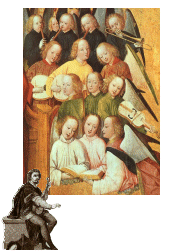|
Composers

Monteverdi

Schütz

Bach

Haydn

Mozart

Beethoven

Berlioz
|
 Cantata
A musical work including soloists,
a choir and an orchestra. The cantata was
originally a singing form only
(as opposed to the sonata, that was meant for playing). In the 16th century,
the cantata was formed as a piece for recitation of rhymed poetry or a
dramatic rhyming movement, by a single singer accompanied by one instrument
(cantata da-camera). Monteverdi
Cantata
A musical work including soloists,
a choir and an orchestra. The cantata was
originally a singing form only
(as opposed to the sonata, that was meant for playing). In the 16th century,
the cantata was formed as a piece for recitation of rhymed poetry or a
dramatic rhyming movement, by a single singer accompanied by one instrument
(cantata da-camera). Monteverdi and Peri
and Peri composed such cantatas but those were considered
inferior to the newly born opera
composed such cantatas but those were considered
inferior to the newly born opera ,
which, unlike the cantata, included acting, costumes and stage design.
Carissimi ,
which, unlike the cantata, included acting, costumes and stage design.
Carissimi improved the cantata in the 17th century and
introduced it into the church. Gradually,
he added accompanying instruments, arias
improved the cantata in the 17th century and
introduced it into the church. Gradually,
he added accompanying instruments, arias (a solo song), and the string orchestra became
the main accompaniment. Pergolesi
(a solo song), and the string orchestra became
the main accompaniment. Pergolesi in Italy
in Italy ,
Couperin ,
Couperin in France
in France ,
Schütz ,
Schütz in Germany
in Germany ,
and many others - all wrote numerous cantatas and prepared the rich soil
on which grew a genius - Johann Sebastian
Bach ,
and many others - all wrote numerous cantatas and prepared the rich soil
on which grew a genius - Johann Sebastian
Bach ,
who composed 300 Church Cantatas ,
who composed 300 Church Cantatas  and a few secular ones (such as the "Coffee
Cantata"), so diverse and different from
each other, that one cannot grasp the musical capacity manifested in each
and every one. Choirs, soloists, duets
and a few secular ones (such as the "Coffee
Cantata"), so diverse and different from
each other, that one cannot grasp the musical capacity manifested in each
and every one. Choirs, soloists, duets and arias are deployed, and the conclusion
is always with a choral, where everybody present in church sings together.
Instruments vary from one piece to another - Bach wrote for the players
available to him at the time.
After Bach, many composers wrote
cantatas of all kinds: Haydn
and arias are deployed, and the conclusion
is always with a choral, where everybody present in church sings together.
Instruments vary from one piece to another - Bach wrote for the players
available to him at the time.
After Bach, many composers wrote
cantatas of all kinds: Haydn ,
Mozart ,
Mozart ,
Beethoven ,
Beethoven ,
Shcubert ,
Shcubert and Berlioz
and Berlioz ,
and until the 20th century ,
and until the 20th century composers like Stravinsky
composers like Stravinsky and Britten
and Britten .
Yet the cantata's climax was in the baroque .
Yet the cantata's climax was in the baroque . .

|
Xtend
 Listen
Listen
 Period
Period
 Notes
Notes
 Internet
Internet
 Dictionary
Dictionary
 Projects
Projects
 Finders
Finders
|